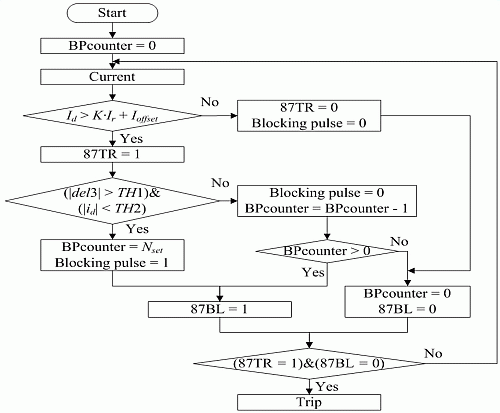Saturation Detection-Based Blocking Scheme for Transformer Differential Protection
Abstract
:1. Introduction
2. Saturation Detection of a Power Transformer Core
2.1. Analysis of an Inrush Current


 ; φ1 = tan−1(ωLm1/R); and for convenience, Ll is ignored.
; φ1 = tan−1(ωLm1/R); and for convenience, Ll is ignored.

 ; and C1 = Vm/Z1.
; and C1 = Vm/Z1.


 ; φ2 = tan−1(ωLm2/R); and C2 = Vm/Z2.
; φ2 = tan−1(ωLm2/R); and C2 = Vm/Z2.
2.2. Detection of Transformer Core Saturation


3. Current Differential Relay with Core Saturation Detection Blocking

3.1. Characteristics of a Current Differential Relay
3.2. Blocking Scheme
3.3. Discrimination between Transformer Saturation and CT Saturation
4. Case Studies


4.1. Magnetic Inrush


4.2. Internal Winding Faults

4.3. Over-Excitation

4.4. External Fault

4.5. External and Internal Faults

5. Conclusions
Acknowledgments
Author Contributions
Conflicts of Interest
References
- Phadke, A.G.; Thorp, J.S. Computer Relaying for Power Systems; Research Studies Press: Hertfordshire, UK, 1988. [Google Scholar]
- Hayward, C.D. Harmonic-current-restrained relays for transformer differential protection. Electr. Eng. 1941, 60, 377–382. [Google Scholar] [CrossRef]
- Mathews, C.W. An improved transformer differential relay. AIEE Trans. Part III 1954, 73, 645–650. [Google Scholar]
- Sharp, R.L.; Glassburn, W.E. A transformer differential relay with second-harmonic restraint. Power Appar. Syst. Part III Trans. Am. Inst. Electr. Eng. 1958, 77, 913–918. [Google Scholar]
- Einvall, C.H.; Linders, J.R. A three-phase differential relay for transformer protection. IEEE Trans. Power Appar. Syst. 1975, 94, 1971–1980. [Google Scholar] [CrossRef]
- Rockefeller, G.D. Fault protection with a digital computer. IEEE Trans. Power Appar. Syst. 1969, 88, 438–462. [Google Scholar] [CrossRef]
- Giuliante, A.; Clough, G. Advances in the design of differential protection for power transformers. In Proceedings of the Georgia Technical Protective Relaying Conference, Atlanta, GA, USA, 1–3 May 1991; pp. 1–12.
- Harder, E.L.; Marter, W.E. Principles and practices of relaying in the United States. Trans. Am. Inst. Electr. Eng. 1948, 67, 1005–1023. [Google Scholar] [CrossRef]
- Phadke, A.G.; Thorp, J.S. A new computer-based flux-restrained current-differential relay for power transformer protection. IEEE Trans. Power Deliv. 1983, 102, 3624–3629. [Google Scholar] [CrossRef]
- Inagaki, K.; Higaki, M.; Matsui, Y.; Kurita, K.; Suzuki, M.; Yoshida, K.; Maeda, T. Digital protection method for power transformers based on an equivalent circuit composed of inverse inductance. IEEE Trans. Power Deliv. 1988, 3, 1501–1510. [Google Scholar] [CrossRef]
- Sachdev, M.S.; Sidhu, T.S.; Wood, H.C. A digital relaying algorithm for detecting transformer winding faults. IEEE Trans. Power Deliv. 1989, 4, 1638–1648. [Google Scholar] [CrossRef]
- Kang, Y.C.; Lee, B.E.; Kang, S.H.; Crossley, P.A. Transformer protection based on the increment of the flux linkages. IEE Proc. Gener. Trans. Distr. 2004, 151, 548–554. [Google Scholar] [CrossRef]
- Bo, Z.; Weller, G.; Lomas, T. A new technique for transformer protection based on transient detection. IEEE Trans. Power Deliv. 2000, 15, 870–875. [Google Scholar] [CrossRef]
- Saleh, S.A.; Rahman, M.A. Real-time testing of a WPT-based protection algorithm for three-phase power transformers. IEEE Trans. Ind. Appl. 2005, 41, 1125–1132. [Google Scholar] [CrossRef]
- Saleh, S.A.; Scaplen, B.; Rahman, M.A. A new implementation method of wavelet-packet-transform differential protection for power transformers. IEEE Trans. Ind. Appl. 2011, 47, 1003–1012. [Google Scholar] [CrossRef]
- Tripathy, M.; Maheshwari, R.P.; Verma, H.K. Radial basis probabilistic neural network for differential protection of power transformer. IET Gener. Trans. Distr. 2008, 2, 43–52. [Google Scholar] [CrossRef]
- Tripathy, M.; Maheshwari, R.P.; Verma, H.K. Power transformer differential protection based on optimal probabilistic neural network. IEEE Trans. Power Deliv. 2010, 25, 102–112. [Google Scholar] [CrossRef]
- Oliveira, L.M.R.; Cardoso, A.J.M. Application of Park’s power components to the differential protection of three-phase transformers. Electr. Power Syst. Res. 2012, 83, 203–211. [Google Scholar] [CrossRef]
- Oliveira, L.M.R.; Cardoso, A.J.M. Extended Park’s vector approach-based differential protection of three-phase power transformers. IET Electr. Power Appl. 2012, 6, 463–472. [Google Scholar] [CrossRef]
- Alencar, R.J.N.; Bezerra, U.H.; Ferreira, A.M.D. A method to identify inrush currents in power transformers protection based on the differential current gradient. Electr. Power Syst. Res. 2014, 111, 78–84. [Google Scholar] [CrossRef]
- Kang, Y.C.; Won, S.H.; Kang, S.H.; Crossley, P.A. A transformer differential relay with core saturation detection algorithm. In Proceedings of the 8th IEE International Conference on Developments in Power System Protection, Amsterdam, The Netherlands, 5–8 April 2004; pp. 368–371.
- Bastard, P.; Bertrand, P.; Meunier, M. A transformer model for winding fault studies. IEEE Trans. Power Deliv. 1994, 9, 690–699. [Google Scholar] [CrossRef]
© 2014 by the authors; licensee MDPI, Basel, Switzerland. This article is an open access article distributed under the terms and conditions of the Creative Commons Attribution license (http://creativecommons.org/licenses/by/3.0/).
Share and Cite
Lee, B.E.; Lee, J.; Won, S.H.; Lee, B.; Crossley, P.A.; Kang, Y.C. Saturation Detection-Based Blocking Scheme for Transformer Differential Protection. Energies 2014, 7, 4571-4587. https://doi.org/10.3390/en7074571
Lee BE, Lee J, Won SH, Lee B, Crossley PA, Kang YC. Saturation Detection-Based Blocking Scheme for Transformer Differential Protection. Energies. 2014; 7(7):4571-4587. https://doi.org/10.3390/en7074571
Chicago/Turabian StyleLee, Byung Eun, Jinsik Lee, Sung Ho Won, Byongjun Lee, Peter A. Crossley, and Yong Cheol Kang. 2014. "Saturation Detection-Based Blocking Scheme for Transformer Differential Protection" Energies 7, no. 7: 4571-4587. https://doi.org/10.3390/en7074571
APA StyleLee, B. E., Lee, J., Won, S. H., Lee, B., Crossley, P. A., & Kang, Y. C. (2014). Saturation Detection-Based Blocking Scheme for Transformer Differential Protection. Energies, 7(7), 4571-4587. https://doi.org/10.3390/en7074571





